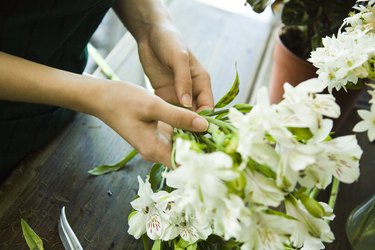
Lilies tend to be one of the most distinctive and popular flowers available in the average florist shop thanks to their delicate shape and strong floral scent. The longer you keep a vase of lilies alive, the longer you get to admire their curled petals and sweet fragrance. Cut lilies can generally last for 10 to 14 days before they start to wilt and turn brown. While lilies come in dozens of unique types, their differences aren't generally significant once they're cut, so it's usually safe to follow the same care instructions for any vase of lilies.
Preparing Lilies for a Vase
Video of the Day
Most of the steps involved with preparing cut lilies for a vase are the same steps you'd follow with any bouquet of cut flowers. Keeping the lilies in water at all times is one of most important things. They tend to be thirsty flowers, and the cut stems shouldn't be allowed to dry out even for a few minutes. If you've received a bouquet of lilies that isn't already in water, put them in a vase with a few inches of water right away.
Video of the Day
When you're ready to arrange lilies, fill a vase almost all the way to the top with room-temperature water. Add flower food, either from the packet that came with the bouquet or by making your own flower food. Use garden shears or clean kitchen scissors to cut the end of each stem on a 45-degree angle, which allows as much water as possible to enter the flower. Trim off any leaves that will fall below the water line in the vase, as letting leaves sit in the water encourages bacterial growth.
One preparation step that's special to lilies involves removing any pollen from the center of each bloom. Pollen is produced by the stamens, and once it's released, the pollen can trigger allergies, stain the lily's petals and speed up the death of the flower. Florists will often remove the stamens before selling lilies, but you may need to do this yourself if you picked your own lilies. Grasp each stamen and gently pull it out of the flower. If any pollen dust falls onto the petals, use a pipe cleaner or clean makeup brush to remove it.
Caring for Lilies in a Vase
Once lilies are arranged in water, place the vase somewhere that stays cool and isn't in direct sunlight. Lilies can be slightly temperamental once cut and don't react well to prolonged heat or light. If your refrigerator is large enough, leave the entire arrangement in there overnight each night.
Check the water every two days. When you see the water level is dropping and/or that the water is turning cloudy, empty and rinse the vase before refilling it with more room-temperature water and another dose of flower food. Trim the stems again, cutting off just a sliver at the end of each stem to create a fresh opening for water.
Cut lilies can be toxic to dogs, cats and humans. If you have pets or young kids in the house, place lilies somewhere that's inaccessible to them. If this isn't possible, like if you have cats who have free rein of the house and love to nibble on plants, stick to some other kind of flower arrangement.
Making Flower Food for Lilies
The flower food that comes with store-bought bouquets is designed to feed the flowers, inhibit bacterial growth and control the water's pH level. You can make your own version using household ingredients you may already have. Try adding 1 teaspoon of sugar (as food), 1 tablespoon of lemon juice (to adjust pH) and 1 teaspoon of bleach (to kill bacteria) to the full vase of water. Some people have success using 1 teaspoon of sugar and 1 teaspoon of apple cider vinegar as flower food, which is a good option if you don't want to handle bleach.